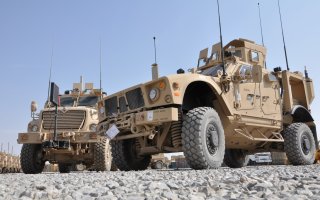China vs. America: Who Will Win the Global 'Armor' Race?
The Chinese Army is adding large numbers of high-altitude armored assault vehicles to their force.
Here's What You Need to Know: The Chinese armored assault vehicle and the U.S. M-ATV may be too heavy for optimized tactical use.
The Chinese Army is adding large numbers of high-altitude armored assault vehicles to their force and is deploying portions of them near its Western border region in the Himalaya plateau regions. The vehicles, called upgraded, third-generation Dongfeng Mengshi are engineered with more armor, mobility and engine power compared with earlier variants.
“A third-generation Dongfeng Mengshi can run on rough roads and arrive in a destination with only 10 minutes that would take an hour on foot, saving stamina and time for the troops, reports quoted the troops stationed in the northern slope of the Himalayas as saying,” a report in the Chinese government-backed Global Times reads.
The vehicles are armed with machine guns, rocket launchers and other weapons, raising interesting questions about just how heavily armored they might be with respect to major mechanized warfare land combat potential.
There may not be a U.S. counterpart per se, as it depends upon the configuration, weaponry, armor composition, suspension and underneath protections of the vehicle, some of which may not be fully known. A cursory look, however, reveals similarities to the U.S. Mine Resistant Ambush Protected All Terrain Vehicle, or M-ATV. The U.S. M-ATV was originally built as part of an urgent need request for off road mobility in Afghanistan in a high improvised explosion device (IED)-threat environment years ago. Oshkosh was awarded a deal to build the M-ATV which was a medium-class armored vehicle engineered with advanced suspension, communications technology and an IED-blast-deflecting V-shaped hull underneath.
Are they potentially comparable in any way? That may not be clear, yet one apparent similarity can be observed through seemingly similar weapons configurations, elevated chassis and armor configuration.
How useful would these vehicles be in any kind of major armored warfare scenario? The U.S. M-ATV, for instance, was primarily envisioned as a counterinsurgency type of platform with seemingly little use in major mechanized war. While built for speed and mobility, they are much heavier and slower than, for instance, the U.S. Joint Light Tactical Vehicle (JLTV). The point being that the Chinese armored assault vehicle and the U.S. M-ATV may be too heavy for optimized tactical use in terms of lower-threat, high-speed patrol or reconnaissance missions, yet not heavy enough to operate effectively in a heavy-armor fight.
An armored column or mechanized unit, for example, will need heavily armored infantry carriers, tanks, artillery and faster, lighter-weight and more mobile tactical vehicles to scout, patrol or conduct forward reconnaissance. These lighter vehicles, such as the U.S. JLTV designed to replace the Humvee, would be protected by close air support and surrounding heavy armored vehicles. Large cargo or troop transport missions are likely to be done by tactical trucks. During the wars in Iraq and Afghanistan, the Army made great efforts to arm higher numbers of tactical trucks with ring mounts for crew served weapons and also add bolt-on armor configurations to withstand RPG, small arms and IED attacks.
Such adaptations, while helpful and of great tactical use for counterinsurgency missions, might not be as necessary or helpful for larger-scaled, mechanized force-on-force warfare. Any kind of large-scale armored attack would, by contrast, likely be heavily armored vehicles supported by well-protected, faster tactical wheeled vehicles.
The flip side of this is that armored warfare itself is expected to become more dispersed, networked, faster-paced and expeditionary. If that is true, then that makes the case for the utility of these kinds of hybrid vehicles which seek to blend armor and mobility into a single platform.
Kris Osborn is the new Defense Editor for the National Interest. Osborn previously served at the Pentagon as a Highly Qualified Expert with the Office of the Assistant Secretary of the Army—Acquisition, Logistics & Technology. Osborn has also worked as an anchor and on-air military specialist at national TV networks. He has appeared as a guest military expert on Fox News, MSNBC, The Military Channel, and The History Channel. He also has a Masters Degree in Comparative Literature from Columbia University.
This article first appeared earlier this year.
Image: Flickr / U.S. Army

